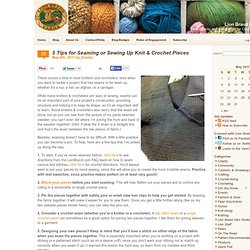

5 Tips For Seaming Or Sewing Up Knit & Crochet Pieces. May 9th, 2011 by Zontee There comes a time in most knitters’ and crocheters’ lives when you want to tackle a project that has seams to be sewn up, whether it’s a top, a hat, an afghan, or a cardigan.

While many knitters & crocheters are wary of sewing, seams can be an important part of your project’s construction, providing structure and helping it to keep its shape, so it’s an important skill to learn. Some knitters & crocheters also worry that the seam will show, but as you can see from the picture of my partly seamed sweater, you can’t even tell where I’m joining the front and back of the sweater together! (Hint: Follow the V down in a straight line and that’s the seam between the two pieces of fabric.) Besides, seaming doesn’t have to be difficult. 1. 2. 3. 4. 5. With a little practice and a little patience, you’ll soon be a seaming queen (or king)!
Color Theory 101: Selecting Yarns That Go Together. A lot of patterns going around at the moment feature stripes: two or three colors that go together perfectly.

You could follow the colors suggested in the pattern sample… but you want to try something a little different. But how in the world do you pick a colors that go together? Color theory. That’s how! Most yarn lines contain a wide range of of colors. Whoa! But don’t fret. It’s not all of the yarns, of course! Most yarn companies design their colors of yarn with compatibility in mind. Fortunately, there’s a name for the art of picking colors that go together: color theory. There are three color schemes that, if followed, will create knock-your-socks-off color combos: analogous, complementary and split complementary. Analogous Analogous colors are the ones that are next to each other on the color wheel: This scheme can work with any number of colors… pick two that are next to each other, three or four! Complementary I love using complementary colors. Split Complementary Related. Duplicate (Embroidery) Stitch On Sweaters & Knit Items. Finishing Seams & Weaving Yarn Tails.
While it may be tempting to hurry through the finishing so you can finally see the completed project, it's important not to rush through sewing the seams and weaving yarn tails if you want the end result to look polished and professional.

Block each piece before assembling, and allow the pieces to dry. This helps the edges remain flat as you work. Shoulder Seams (bound-off edges) Step 1: Lay both pieces flat, with right sides facing up. Thread a yarn needle, and, beginning at the right-side edge of the piece closest to you (the lower piece), insert the needle from back to front through the center of the first stitch. Step 2: Insert the needle from right to left under the two vertical legs of the first stitch on the piece farther from you (fig. 25a), then insert the needle from right to left under the next two vertical legs on the near piece, beginning in the same hole as the first stitch was made. Shoulder Seams: Figure 25a Mattress Stitch Mattress Stitch: Figure 25b Backstitch.